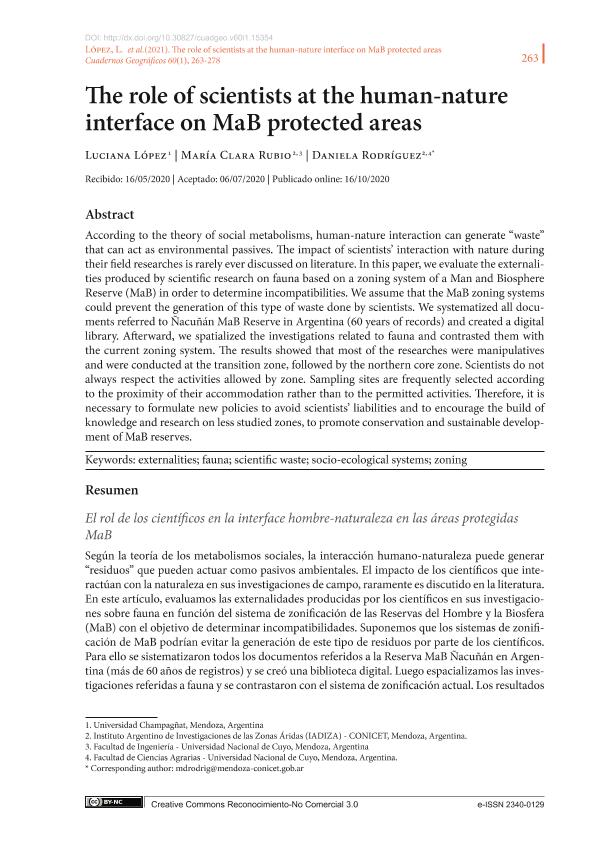Artículo
According to the theory of social metabolisms, human-nature interaction can generate “waste” that can act as environmental passives. The impact of scientists’ interaction with nature during their field researches is rarely ever discussed on literature. In this paper, we evaluate the externalities produced by scientific research on fauna based on a zoning system of a Man and Biosphere Reserve (MaB) in order to determine incompatibilities. We assume that the MaB zoning systems could prevent the generation of this type of waste done by scientists. We systematized all documents referred to Ñacuñán MaB Reserve in Argentina (60 years of records) and created a digital library. Afterward, we spatialized the investigations related to fauna and contrasted them with the current zoning system. The results showed that most of the researches were manipulatives and were conducted at the transition zone, followed by the northern core zone. Scientists do not always respect the activities allowed by zone. Sampling sites are frequently selected according to the proximity of their accommodation rather than to the permitted activities. Therefore, it is necessary to formulate new policies to avoid scientists’ liabilities and to encourage the build of knowledge and research on less studied zones, to promote conservation and sustainable development of MaB reserves. Según la teoría de los metabolismos sociales, la interacción humano-naturaleza puede generar “residuos” que pueden actuar como pasivos ambientales. El impacto de los científicos que interactúan con la naturaleza en sus investigaciones de campo, raramente es discutido en la literatura. En este artículo, evaluamos las externalidades producidas por los científicos en sus investigaciones sobre fauna en función del sistema de zonificación de las Reservas del Hombre y la Biosfera (MaB) con el objetivo de determinar incompatibilidades. Suponemos que los sistemas de zonificación de MaB podrían evitar la generación de este tipo de residuos por parte de los científicos. Para ello se sistematizaron todos los documentos referidos a la Reserva MaB Ñacuñán en Argentina (más de 60 años de registros) y se creó una biblioteca digital. Luego espacializamos las investigaciones referidas a fauna y se contrastaron con el sistema de zonificación actual. Los resultados mostraron que la mayor parte de las investigaciones fueron manipulativas y se localizaron en la zona de transición, seguida de la zona del núcleo norte. Los científicos no siempre respetaron las actividades permitidas por zona, seleccionando sus sitios de muestro en función de la proximidad a su alojamiento. Por ello es necesario formular políticas para evitar las responsabilidades de los científicos y para orientar la generación de conocimientos en las zonas menos estudiadas a efectos de promover la conservación y el desarrollo sustentable de las Reservas MaB.
The role of scientists at the human-nature interface on MaB protected areas
Título:
El rol de los científicos en la interface hombre-naturaleza en las áreas protegidas MaB
Fecha de publicación:
10/2020
Editorial:
Universidad de Granada
Revista:
Cuadernos Geográficos
ISSN:
0210-5462
Idioma:
Inglés
Tipo de recurso:
Artículo publicado
Clasificación temática:
Resumen
Palabras clave:
EXTERNALITIES
,
FAUNA
,
SCIENTIFIC WASTE
,
SOCIO-ECOLOGICAL SYSTEMS
,
ZONING
Archivos asociados
Licencia
Identificadores
Colecciones
Articulos(IADIZA)
Articulos de INST. ARG DE INVEST. DE LAS ZONAS ARIDAS
Articulos de INST. ARG DE INVEST. DE LAS ZONAS ARIDAS
Citación
López, Luciana; Rubio, María Clara; Rodriguez, Maria Daniela; The role of scientists at the human-nature interface on MaB protected areas; Universidad de Granada; Cuadernos Geográficos; 60; 1; 10-2020; 263-278
Compartir
Altmétricas




